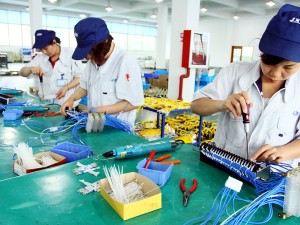
In this picture taken on May 31, 2012, shows Chinese workers assembling computers at a factory in Jiashan, east China's Zhejiang province. China's manufacturing activity grew at a markedly lower rate in May, official data showed on June 1, providing further confirmation that the world's number two economy is slowing rapidly. AFP
NEW DELHI — Factory activity weakened across Asia in May, indices showed Friday, with China’s manufacturing sector slowing sharply as fears grow for the global economy.
The regional weakness in manufacturing adds to pessimism over the US recovery and continuing eurozone turbulence as Spain’s banking sector looks increasingly fragile.
China’s official purchasing managers’ index (PMI) for manufacturing indicated a steeper than expected slowdown in April, while separate data released by British banking giant HSBC showed a contraction for the same month.
The HSBC data marked the seventh consecutive contraction in manufacturing activity and the bank’s chief China economist Qu Hongbin said the figure pointed to a slowing of the economy.
“May’s final reading confirmed that manufacturing growth slowed further on weakening demand from both global and domestic markets,” he said.
“This points to a continuous slowdown of the real economy in the second quarter and should promote Beijing to step up easing efforts in the coming months.”
HSBC’s PMI data for May stood at 48.4 compared with 49.3 in April, as demand slowed in both China’s own markets and abroad.
The official data showed a smaller than expected expansion in the sector, with the PMI falling to 50.4 from 53.3 in April, according to the China Federation of Logistics and Purchasing.
For PMI readings, above 50 indicates expansion while a reading below 50 suggests contraction.
A PMI released Friday for Australia showed its sector falling deeply into contraction territory, down 1.5 points in May to 42.4.
Indexes in South Korea and Taiwan remained barely positive but both showed growth slowing, with South Korea’s HSBC PMI falling to 51.0 from 51.9, and Taiwan’s to 50.5 from 51.2.
South Korea also reported exports declined year-on-year for a third straight month in May.
HSBC’s PMI for Indonesia fell to 48.1 in May from 50.5 in April, led by a decline in new orders.
“The green shoots of recovery that we were seeing a month or so back are wilting away,” said Rob Subbaraman, chief Asia economist at Nomura Securities.
“The crisis in Europe is one reason; the other one is the China slowdown. But I think less appreciated is that the height of uncertainty about the outlook has caused Asian firms and multinationals in Asia.”
The factory sector in India expanded in May at the same modest rate as in April, HSBC figures showed a day after the release of dire growth data in Asia’s third-largest economy.
India’s PMI was marginally down to 54.8 in May from 54.9 in April.
Official data a day earlier showed that India’s economy grew at a near-decade low of 5.3 percent in the January to March quarter, well below analysts’ 6.1 percent forecasts.
“Inflation is still high and capacity remains tight with backlogs of work rising,” HSBC’s chief India economist Leif Eskesen said in a statement.
The Reserve Bank of India reduced rates in April, its first such move in three years, after hiking borrowing costs 13 times since March 2010 to curb stubbornly high prices.